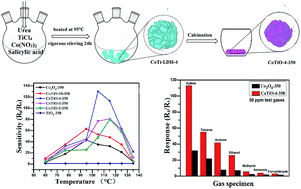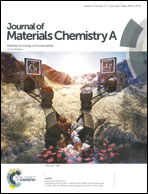Facile synthesis of mesoporous hierarchical Co3O4–TiO2 p–n heterojunctions with greatly enhanced gas sensing performance†
Abstract
The development of highly active, sensitive and durable gas sensing materials for the detection of volatile organic compounds (VOCs) is extremely desirable for gas sensors. Herein, a series of mesoporous hierarchical Co3O4–TiO2 p–n heterojunctions have been prepared for the first time via the facile thermal conversion of hierarchical CoTi layered double hydroxides (CoTi-LDHs) precursors at 300–400 °C. The resulting Co3O4–TiO2 nanocomposites showed superior sensing performance towards toluene and xylene in comparison with Co3O4 and TiO2 at low temperature, and the sample with a Co/Ti molar ratio of 4 shows an optimal response (Rg/Ra = 113, Rg and Ra denote the sensor resistance in a target gas and in air, respectively) to 50 ppm xylene at 115 °C. The ultrahigh sensing activity of these Co3O4–TiO2 p–n heterojunctions originates from their hierarchical structure, high specific surface area (>120 m2 g−1), and the formation of numerous p–n heterojunctions, which results in full exposure of active sites, easy adsorption of oxygen and target gases, and large modulation of resistance. Importantly, hierarchical Co3O4–TiO2 heterojunctions possess advantages of simple preparation, structural stability, good selectivity and long-term durability. Therefore, this work provides a facile approach for the preparation of hierarchical Co3O4–TiO2 p–n heterojunctions with excellent activity, sensitivity and durability, which can be used as a promising material for the development of high-performance gas sensors.



 Please wait while we load your content...
Please wait while we load your content...